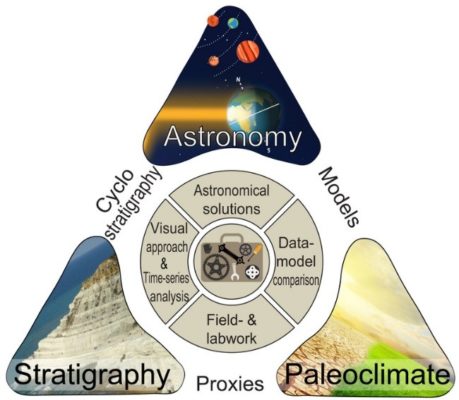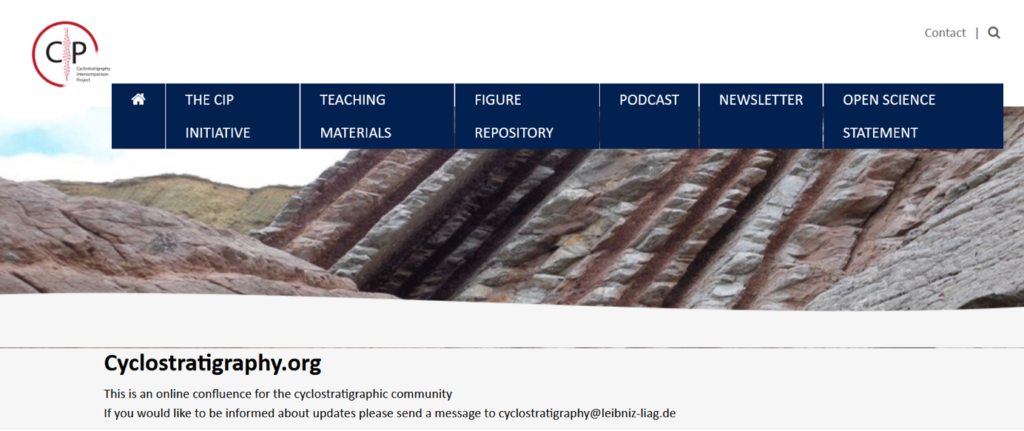
Cyclostratigraphers aim to read and understand the effect of climate-driven orbital changes in the geological record through time. In doing so, they start from an important prerequisite: An imprint of insolation variations caused by Earth’s orbital eccentricity, obliquity and/or precession (Milankovitch forcing) can be preserved in the geological rock record. The new www.cyclostratigraphy.org website is a learning platform for all geoscientists who want to learn more about the concepts and techniques that underpin our discipline. The website is also open to cyclostratigraphers and lecturers who search for inspiration for their lectures, or who intend to communicate their scientific findings on all kinds of rhythms in the Earth system.
The website is the translation of the lessons learned during the Cyclostratigraphic Intercomparison Project (CIP). In 2018, the cyclostratigraphic community assessed the robustness of their methods using an experimental design of three artificial geologic case studies with known input parameters. The experiment demonstrated that cyclostratigraphy is a powerful tool for deciphering time in sedimentary successions and, importantly, that it is a trainable skill. The website is intended to provide high-quality learning materials in the field of cyclostratigraphy. In that regard, we are building a lecture series on several topics and subjects of cyclostratigraphy taught by experienced lecturers from the field. We also have a figure repository, from which everyone can mine when pulling together their own teaching materials, including a suite of relevant figures, which were made with the aim of open usage by the community. A second purpose of www.cyclostratigraphy.org is to bring together and organize the cyclostratigraphic community by providing a platform where scientific results can be announced and open questions can be discussed. In this regard, the newsletter and the podcast are of great importance. The lecture and podcast series are steadily growing, and we would like to highlight the excellent introduction lecture by Frits Hilgen (Utrecht University) and the lecture on astronomical forcing of shallow-water depositional environments by André Strasser (University of Fribourg). Overall, the website has the ambition to actively support the robustness of cyclostratigraphic applications in Earth sciences, as well as to enable the learning of cyclostratigraphy to everyone, anywhere, independent of financial or physical abilities.
A triangle-shape logo (see Feature image) was designed to be composed of the three main disciplines of cyclostratigraphy: Astronomy, stratigraphy and paleoclimate. The three corner stones are then connected by a list of techniques, tools and skills often applied in this field. For example, field and lab work is the starting point of the consequent time-series analysis, and the modelling forms the linkage between astronomical parameters and consequent climate change. In our opinion, this logo reflects the true multidisciplinary character of cyclostratigraphy as a discipline, and summarizes most relevant aspects.

Figure 1: A caption of the webpage Cyclostratigraphy.org offering all kinds of information for the community.
The beating heart of the online learning platform is constituted by the teaching materials. However, the website also includes background information of the initiative, a figure repository where free-to-use figures related to cyclostratigraphy are deposited, a podcast series, a newsletter and an open science statement.
This is a co-blog of the EGU divisions Stratigraphy, Sedimentology and Palaeontology and Climate: Past, Present & Future and has been edited by both editorial teams.
Reference: Sinnesael, M., De Vleeschouwer, D., Zeeden, C., Batenburg, S.J., Da Silva, A.-C., de Winter, N.J., Dinarès-Turell, J., Drury, A.J., Gambacorta, G., Hilgen, F.J., Hinnov, L.A., Hudson, A.J.L., Kemp, D.B., Lantink, M.L., Laurin, J., Li, M., Liebrand, D., Ma, C., Meyers, S.R., Monkenbusch, J., Montanari, A., Nohl, T., Pälike, H., Pas, D., Ruhl, M., Thibault, N., Vahlenkamp, M., Valero, L., Wouters, S., Wu, H., Claeys, P., 2019. The Cyclostratigraphy Intercomparison Project (CIP): consistency, merits and pitfalls. Earth-Sci. Rev. 102965. https://doi.org/10.1016/j.earscirev.2019.102965
